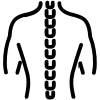Do you sit in front of a computer for hours every day? We can’t always change the jobs we work, but we can change how we work them. An ergonomic workspace can give your health and productivity a major boost. Read on to learn how to make your workspace better for your mind and body.
What Is An Ergonomic Workspace?

An ergonomic workspace is a workspace that makes workers safer, more comfortable, and more productive while reducing their risk of posture-related health problems.
An ergonomic workspace often includes:
Dynamic Sitting
Sitting for long hours is dangerous for your health. Some ergonomic chairs, like ball seats, let you engage in “dynamic sitting”—a way of sitting in which you frequently change positions. Dynamic sitting keeps you more active and helps you feel less tired during the day.
The Bloon ball seat, for example, is specially designed for dynamic sitting. You can learn more about the Bloon in our article, The Bloon Active Seat.
Adjustable Desk Height
If your desk isn’t the right height for you, it can cause pain and muscle problems. An ergonomic workspace should allow you to change your desk’s height. If you’re sitting down, your elbows should be at a 90° angle to the desk.
Freedom of Movement
An ergonomic workspace should allow you to move about freely. You should have space underneath your desk—not boxes or other material crowding your legs. When you can move freely, you tend to have better circulation, since you aren’t restricted to a single position. Better circulation also keeps you from feeling tired during the workday.
A Customizable Workspace
Your desk accessories, like your keyboard, screen, and mouse, should also be adjustable. Your computer screen should be at eye level or slightly lower to prevent neck tension, and it should be about an arm’s length from your face to prevent you from straining your eyes. Your keyboard and your mouse should be positioned in such a way that your elbows are at a 90° angle and your arms are slightly bent.
Adequate Lighting
Your workspace should have enough light that you don’t have to strain your eyes to see. The light should be adjustable and placed somewhere that it doesn't create glare on your screen. Proper lighting reduces eye strain and makes your space feel more pleasant to work at.
Choose the Right Furniture
Standing Desk
A standing desk lets you change the height of your desk as you please and switch between sitting and standing throughout the day. Changing your working position is great for improving your circulation, reducing fatigue, and maximizing your productivity.
Footrest
A footrest can be a helpful accessory in an ergonomic workspace, especially if your feet don’t reach the ground when you’re sitting down. A footrest helps you improve your posture by supporting your feet and reducing pressure on your lower back and legs. Choose a footrest that lets you adjust both the angle and the height.
Sit with Good Posture
Good posture is key when it comes to preventing pain, back problems, and musculoskeletal disorders. It not only helps you be more energized and productive at work—it helps you feel better all around.
The height of your seat should allow your feet to rest flat on the ground or on a footrest with your knees bent at a 90° angle. Make sure to sit on an an ergonomic chair or ball seat with good lumbar support to maintain the natural curve of your spine. The Bloon ball seat’s ergonomic design allows it to naturally support your lower back and your posture.
Your desk should be positioned at a height that lets you bend your elbows at a 90° angle. Your screen should be about one arm’s length from you, at eye level or slightly lower. Position your keyboard so that your wrists are aligned with your forearms, and place your mouse near your keyboard so you don’t have to move your arms too much.
As you work, keep your back straight, your shoulders relaxed, and your head aligned with your spine. Don’t lean forward or slouch.
If you want to learn more about how to have a better posture at work or at home, check out our article.
Stay Active
A healthy lifestyle requires movement—even on the job. Spending long hours in the same position is harmful to your health. Doing simple exercises during your workday can reduce your risk of musculoskeletal disorders, improve your circulation, and make you more productive.
We recommend adding both stretches and strength training to your routine. Check out our articles below for hints, tips, and inspiration:
- 10 Easy Ball Seat Exercises to Keep You Active at Work
- 12 Stretches You Can Do at Your Desk to Relieve Stress and Muscle Tension
Making your workspace more ergonomic requires just a few simple tools and a little bit of know-how. Furniture like ergonomic ball seats can improve your posture naturally without putting pressure on your lower back, while a standing desk can keep you from remaining too long in the same position. Make sure that your workspace is well-lit and that your mouse, screen, and keyboard are all correctly positioned in relation to your body.
FAQ: Making Your Workspace More Ergonomic
What Is an Ergonomic Workspace?
An ergonomic workspace is a workspace that helps you feel more comfortable and be more productive on the job. It should be adapted to your physical needs, which means having an adjustable seat, a desk that’s the right height for your body, and correctly placed accessories. An ergonomic workspace will reduce your risk of developing musculoskeletal disorders.
How Can I Make My Workspace More Ergonomic?
Getting an ergonomic ball seat is an excellent first step, as it naturally improves your working posture. A standing desk is also a practical investment. Make sure, too, that your screen is at eye level and your keyboard and your mouse are aligned with your wrists.
What Should an Ergonomic Workspace Have?
An ergonomic workspace should have:
- A seat you can adjust so that your feet are flat on the ground
- Lumbar support that maintains the natural curve of your back
- A desk whose height can be adjusted so that your elbows are bent at a 90° angle
- A screen at eye level, one arm’s length from you
- A keyboard and mouse positioned so that your wrists and forearms are aligned, to prevent wrist tension
- Adequate lighting, to prevent glare and eye strain
Why Does Ergonomics Matter?
The goal of ergonomics is to adapt the workspace to meet the needs of the employee, helping them work more safely and comfortably in the process. An ergonomic workspace reduces stress and fatigue while making you more productive.
How Can I Work More Ergonomically?
Sit with correct posture and make sure that your lower back is supported. Take breaks to stretch, organize your space so that you don’t have to reach too far for anything, use ergonomic accessories, and add more exercise into your routine.
What Is Proper Posture for Working?
Keep your back straight, feet flat on the ground, shoulders relaxed, and head aligned with your spine. Your elbows should be at a 90° angle and your forearms parallel to the ground.
How Do Ergonomic Workspaces Benefit Employees?
An ergonomic workspace makes employees less likely to deal with pain and injuries, improves their posture, makes them feel more comfortable, and increases their productivity. It also reduces stress, increases energy, and enhances their overall well-being while lessening the amount of sick days they have to take.











